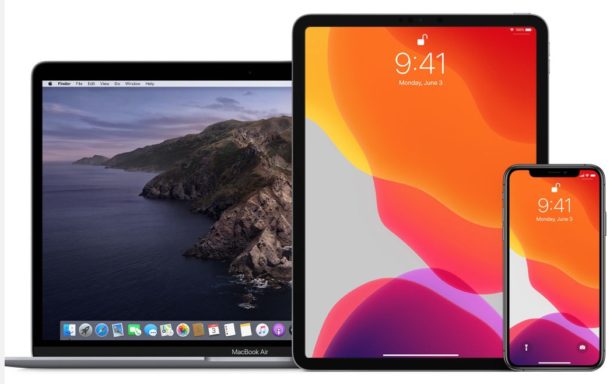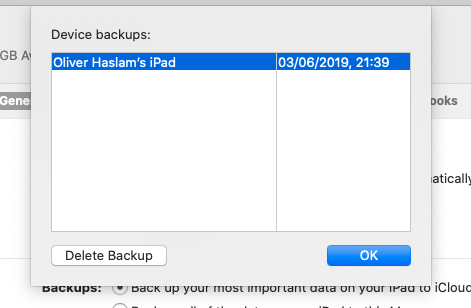How to Delete iPhone & iPad Backups with Finder in MacOS Big Sur & Catalina

Need to clear up some disk space or get rid of some old iPhone or iPad backups on a Mac? With the latest versions of MacOS, managing iOS and iPadOS device backups is done entirely in Finder, including deleting and removing device backups.
Arguably the safest and most thorough way of backing up an iPhone or iPad is to do an encrypted backup via Mac Finder. When the backup is complete you’ll have a copy of all of your data on your computer, complete with encrypted keychain contents. But it all takes up space that you might want to reclaim. As you can imagine, doing a full backup of your iPhone or iPad can take a lot of space. That’s fine if you’re lucky enough to be using a Mac with a multi-terabyte SSD. But most of us aren’t, so we need a way to trip the amount of data used by backups. We need to delete old ones. And in macOS Catalina, that’s a whole new process compared to deleting backups with iTunes. As you’ll see, removing backups this way is similar, but since iTunes is no more in modern macOS versions, it’s obviously a bit different and using a different process.
Here’s how to go about deleting old iPhone or iPad backups in macOS Catalina.
How to Delete iOS & iPadOS Device Backups from MacOS Finder in Big Sur & Catalina
This assumes you have made a backup of iPhone or iPad to macOS before, if not there will not be any backup to remove.
- Plug your iPhone or iPad into your Mac using a USB cable.
- Open a Finder window by clicking its icon in the Dock and click your iPhone or iPad in the sidebar.
- Make sure that the “General” tab is selected and then click “Manage Backups.” You’ll find it at the very bottom of the window.

- Click to select the backup that you want to delete and then click “Delete Backup.”

- You’ll need to confirm that you want to delete the selected backup before the action is carried out.
The selected backups will be deleted.
Depending on the size of the device backups you removed, you can possibly get a ton more space on your Mac drive, whether it’s a hard disk or SSD, just by removing backups this way. This is particularly nice to do with old device backups that are no longer needed.
Of course you don’t want to delete the only copy of a device backup you have, so be sure you have a backup of the iPhone or iPad somewhere before deleting one from the Mac.
As a bonus, you’ll still have these backups safe and sound if you’re using Time Machine, assuming you use that feature to backup the entire Mac anyway. You can then go about restoring the backup if you still need it, depending on how much time has passed and how long Time Machine keeps files around. Another handy trick for redundant backups is to manually copy a copy of the backed up devices to other external storage mediums, like an SD card, USB flash drive, or external hard drive, which you can then refer to if needed.
Using a Mac is just one way of backing up your iPhone or iPad. You can also use a Windows PC with iTunes if you want to. If you’d rather not have to plug them into a computer at all, you can use iCloud for backups instead as well. With iCloud, your device will back itself up overnight and you won’t need to connect to a computer to restore anything, either. And just like the Mac and iTunes approaches, you can also delete backups from iCloud too.
Finder in MacOS handles all device management now that iTunes used to, and that includes not only device backups but also syncing music to iPhone or iPad in MacOS with the Finder too, along with other device management options. Basically all that used to be device management in iTunes is now in Finder.
If you know of any other approaches to deleting and removing device backups from modern MacOS versions, share with us in the comments!




It;s unlikely if you need to open up drive space you’re going to claim enough doing this, and you’re deleting exactly what you purposely backed up.
Better option is look into possibility of putting in a larger drive (SSD absolutely) or move these to another drive, USB stick, external drive, etc.
If you’re getting a low on or out of space warning, you need to consider freeing up at least 30% of your drives total capacity or you will just keep getting this warning as you fill the drive up again.
Newer macs it’s difficult to impossible to swap the internal drive for a larger one, but any Mac that uses a user removable drive I highly recommend you get a bigger one in SSD (solid state drive) format, and using the backup you should be regimentally keeping up to date, either use Time Machine or a clone (my preference) like CarbonCopyCloner or SuperDuper to assist in the drive exchange.